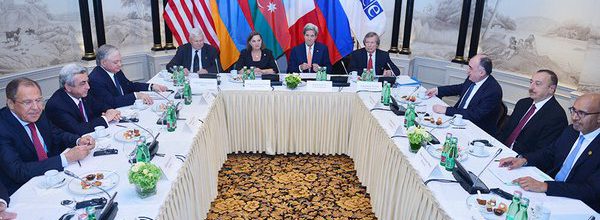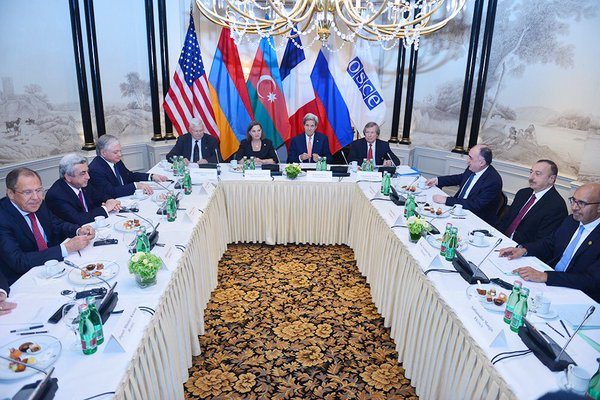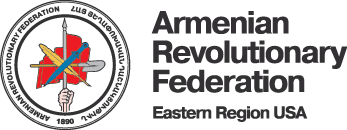Sarkisian, Aliyev Meet with Co-Chair Representatives; NKR Serviceman Killed on LoC

Sarkisian and Aliyev to Meet Next Month
VIENNA, Austria (A.W.)—An Armenian serviceman was killed on the Artsakh (Nagorno-Karabagh Republic/NKR) Line of Contact (LoC) overnight on May 16-17, hours after Armenian President Serge Sarkisian and Azerbaijani President Ilham Aliyev met with the Organization for Security and Co-operation in Europe (OSCE) representatives on May 16.
According to a press statement released by the NKR Defense Ministry, Armenian serviceman Khachatur Harutyunyan (b. 1996) was killed at 12:50 a.m. Yerevan time at the southern direction of the LoC. According to the ministry, Azerbaijani forces violated the terms of the ceasefire agreement by using firearms of various calibers, including armored vehicle guns, mortars, and grenade-launchers.
Sarkisian and Aliyev met the Secretary of State of the United States John Kerry, Foreign Affairs Minister of Russia Sergey Lavrov, and State Secretary for European Affairs of France Harlem Desir, representing the co-chair countries of Minsk Group in Vienna, to discuss a peaceful resolution to the conflict in NKR.

U.S. Secretary of State John Kerry, Russia Foreign Minister Sergei Lavrov, and France State Secretary for European Affairs Harlem Desir with Armenian President Serge Sarkisian and Azerbaijani President Ilham Aliyev during discussions of NKR peace on May 16, in Vienna, Austria
Co-Chairs: Sarkisian and Aliyev to Meet in June
According to a joint statement released by the representatives of the three Minsk Group co-chair countries following the meeting, the two presidents agreed on a next round of talks, to be held at a mutually agreed place next month, with an aim to “resuming negotiations on a comprehensive settlement.” The statement also said that Sarkisian and Aliyev “reiterated their commitment to the ceasefire and the peaceful settlement of the conflict” during the gathering.
“To reduce the risk of further violence, they [Sarkisian and Aliyev] agreed to finalize in the shortest possible time an OSCE investigative mechanism. The Presidents also agreed to the expansion of the existing Office of the Personal Representative of the OSCE Chairperson in Office,” read a part of the statement.
According to the statement, the two also agreed to continue the exchange of data on missing persons under the auspices of the International Committee of the Red Cross (ICRC)—an agreement that had been reached during the October 2014 Paris summit.
Following the meeting, Sarkisian’s press office released a report about the gathering, which said that the co-chair countries’ representatives stressed the importance of a “strict implementation” of the 1994 ceasefire and 1995 reinforcing agreements.
“Agreement was reached to initiate steps on the introduction of monitoring of their implementation and mechanisms of investigation of incidents, the increase of the possibilities of the personal representative of the OSCE Chairman-in-Office, in the direction of the possible resumption of the negotiating process on conflict settlement,” read a part of Sarkisian’s press statement.
While returning to Yerevan from Vienna, Sarkisian was interviewed by a group of Armenian journalists aboard his presidential jet. During his interview, Sarkisian said that the objective of the Armenian side was to find out whether negotiations on NKR had reached a stalemate and whether or not it could be solved without a full-scale war.
“In general, my colleagues and I are satisfied with the results of the meeting, and we can speak about this more clearly, when the co-chairs’ statement is released. But nevertheless, the Azerbaijani president gave assurances that his country and he have no intention of achieving a military solution to the problem,” he said, as quoted by Armenianow.com.
Hamparian: ‘We Hope that this Failed Policy of False Parity Will Finally Be Put to an End’
Commenting on the meeting, Armenian National Committee of America (ANCA) Executive Director Aram Hamparian said that he hoped that the Vienna summit would serve as an opportunity to end the Minsk Group’s “false parity.”
“Reports from today’s meeting between President Sarkisian and President Aliyev calling for mechanisms to monitor the Nagorno-Karabagh ceasefire and increase the OSCE Minsk Group observer presence in the region represent promising early indications that the international community, after far too many years of appeasing Baku, may be willing to take meaningful steps to confront and constrain Azerbaijan’s escalating aggression against both Artsakh and Armenia,” read a part of Hamparian’s statement.
Hamparian also called on the OSCE Minsk Group and the international community “to clearly and unequivocally condemn Azerbaijan’s obstruction of these confidence building measures.”
“The OSCE’s counter-productive pattern of artificial even-handedness in the face of Azerbaijan’s ongoing ceasefire violations and escalation of violence has only served to embolden President Aliyev’s march toward war. We hope that this failed policy of false parity will finally be put to an end with this Vienna meeting,” read a part of Hamparian’s statement.
The joint meeting with OSCE co-chair representatives is the first gathering of the two presidents after the large-scale military offensive launched by Azerbaijan early last month. Overnight on April 1-2, Azerbaijani forces launched a full-blown attack on multiple positions of the NKR Line of Contact (LoC).
The Azerbaijani Army employed tanks, military helicopters, drones, and various caliber weapons in an assault that targeted the LoC on the southern, southeastern, and northeastern fronts. The NKR Defense Army retaliated and, according to the NKR Defense Ministry, brought down two helicopters and two drones, and destroyed three tanks on that first day.
Azerbaijan’s attacks on NKR continued in the ensuing days, resulting in the death of more than 90 Armenians—servicemen and civilians—between April 2 and 5.
Senior U.S. State Department Officials Comment Ahead of Meeting
During a special briefing ahead of the meeting by two senior U.S. State Department officials whose titles were withheld by the department, one of the officials said that an issue that needs to be resolved is what he called “status for Nagorno-Karabagh.”
“[The] presidents agree that there needs to be an expression of the will of the population of Nagorno-Karabagh at some time to decide Nagorno-Karabagh’s future. Of course, the Armenians would like a date set and would like to have that referendum done as soon as possible,” he said, adding that the State Department’s answer to that is “that’s not the only issue in play, and when we talk about a comprehensive settlement, we need to talk about all of these elements and principles.”
The official also estimated that a total of 350 people—military and civilian—died in early April during the heightened aggression. “There are literally dozens of casualties each year, and as you may know, fighting flared up dramatically in early April, April 2 to April 5—so-called 4-day war—with hundreds of casualties—an estimated 350 casualties including civilians,” the official said.
Commenting on the effectiveness on the talks between Sarkisian and Aliyev, the same State Department official said that he finds it “remarkable” that the two can talk to each other. “What we’ve done with them in the past—and I don’t think we’ll have the opportunity tonight; we’re using a different format—is that we’ve allowed them as much time as they want one on one. We put a bottle of scotch on the table and allow them to talk through the issues, and what we’ve learned is they do talk through the issues,” the official said.
According to the official, the two presidents “aren’t that far apart” on the issues they need to be discussing. “Now, with a strong push from Secretary Kerry and Foreign Minister Lavrov tonight, we hope that we can find a way into those negotiations,” the official said.
Source: Armenian Weekly Mid-West
